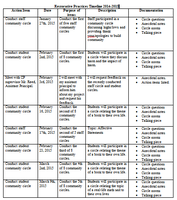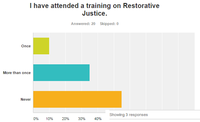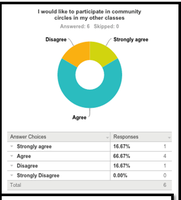PLI Leadership Project: Implementing Restorative Practices at Locke High School

I. Project Overview
"I destroy my enemies when I make them my friends" -Nelson Mandela
The Need for Restorative Practices
"Black students are three times more likely to be suspended than their white counterparts for comparable offenses" (Davis, 2014)
During the 2013-2014 school year, Locke High School reported 379 suspensions out of a student population of 1763 students, resulting in a suspension rate of 21.5%. This statistic is significantly higher that LAUSD's reported suspension rate of 1.5% last year. Demographically, Locke's student population is 99% African-American and Latino, which means that virtually all of the 379 suspensions were applied towards students of color, mirroring the disproportionate rates at which students of color are suspended across the state and district. For example, in Los Angeles Unified, African American students are suspended at nearly 6 times the rate than whites. In addition to the jarring inequity of this situation, two decades of research have demonstrated that there is “no research base to support" any effectiveness of "frequent suspension or expulsion in response to non-violent and mundane forms of adolescent misbehavior:. Instead, "frequent suspension and expulsion are associated with negative outcomes ... and better alternatives are available."
I took on this leadership project in order to implement Restorative Practices as an alternative to punitive discipline at Locke. The traditional punitive model responds to harm by replicating harm against the offender. In contrast, Restorative Justice seeks to repair harm by 1) asking who was harmed and figuring out the needs and obligations of all affected and by 2) proactively building community amongst all members of the school community before conflict arises in the first place.
Circles and the Restorative Process Explained
The philosophy of Restorative Justice is rooted in indigenous culture, beginning with the Maori people who use the practices as a way to solve conflict and address harm within the community.

After witnessing a significant decline in the crime rates amongst the Maori, the United States criminal justice system began implementing Restorative Justice practices. Following the success within the US judicial system, proponents of Restorative Practices advocated for its implementation in schools
Community circles are a technique associated with the Restorative Practices framework. During community circles, facilitators use a series of questions to establish trust and community within a group. The community circle process begins with an identification and explanation of circle values. After values and norms have been established, the circle facilitator poses the first question to the group and asks for a volunteer to begin. The talking piece is then passed to the left. After the talking piece makes its way around the circle, it is passed around a second time to allow for participants to add anything to their initial responses. After the talking piece has been passed around twice, the circle facilitator poses the second question to the group and continues the process until the final reflection question is complete. It is important to note that associated with the restorative practices framework is the implementation of harm and re-entry circles. However, due to the current phase of the roll-out plan, this project will not address the implementation of these circles on campus.
Project Outline
 The full implementation of Restorative Practices would take several years, and include the hiring of a full time Restorative Practices Coordinator. This year, I aimed to create the foundation for such a program at Locke by introducing teachers to Restorative Practices and the rationale and research behind it, by training teachers on how to conduct circles, and by practicing using Community Circles with the staff in order to familiarize them with the process as well as build stronger relationships amongst the adults on campus.
The full implementation of Restorative Practices would take several years, and include the hiring of a full time Restorative Practices Coordinator. This year, I aimed to create the foundation for such a program at Locke by introducing teachers to Restorative Practices and the rationale and research behind it, by training teachers on how to conduct circles, and by practicing using Community Circles with the staff in order to familiarize them with the process as well as build stronger relationships amongst the adults on campus.
My project encompassed the two phases detailed on the right: Phase 1: collect of data and research, Phase 2: build the foundation for Restorative Practices with staff.
Details of Implementation

A snapshot of the timeline of activities is shown on the right. However, the full timeline is much longer, and is included in the appendix below. We conducted 5 Community Circles with the staff and 8 with the students, with the prompts and other details outlined in the timeline document. With both groups, we began with introductory prompts in order to familiarize participants with the process and norms. Over subsequent meetings, we asked deeper questions aimed at having participants share increasingly personal experiences and feelings regarding their school and life. Nearer the end of the cycle, prompts were designed to promote reflection of the Restorative Practices experience as well as closure to the school year. Sample staff prompts include:
- If you could write each student (or one particular student) a letter, what would you want them to know, and why?
- I feel loved/appreciated by my students when ...
- Think back to a moment where a student's behavior made you angry. How might you have better handled the situation, perhaps using an affective statement?
Anticipated Short/Long Term Outcomes

Anticipated short and long term outcomes for my project are listed to the right. As the project leader for Academy C, I worked primarily with Sofia Leal (SPED Team Lead) to train the staff on Restorative Practices and to plan and conduct the monthly staff Community Circles. Brian Reed, our Assistant Principal, provided logistical support, including securing a space for the circles, printing materials, and lending us a talking piece. Faculty members and students provided us with ongoing feedback in improving our circles and ensuring that the practice remained relevant to the needs of our school.
II. Project Data
Hawkins High School Exploratory Report (Sept 2014)
Along with the Locke Restorative Justice Exploratory Team, I created a 43-slide report outlining the following recommendations derived from student and staff interviews at Hawkins High School:
|
|
Notable recommendations include the necessity of an on-campus Restorative Practices Coordinator, scheduled community circles for staff members, and explicit training for staff members. Interviewed staff noted that addressing these key areas would increase teacher and student buy-in and contribute significantly to the overall success of the program.
|
Staff Pre and Post Assessment (Nov 2014 --> May 2015)
The data displayed below was collected by survey from the Academy C staff before and after implementation of the Leadership Project. The results clearly demonstrate an increased understanding and familiarity with Restorative Practices. Staff continues to support program as they initially did, but they still feel the need for additional training specific to conducting community and conflict circles with students.
|
Pre-Assessment (Nov 2014) |
Post-Assessment (May 2015) | |
|
|
 |
 |
|
|
 |
 |
|
|
 |
 |
|
|
 |
 |
As the above data suggests, the implementation of community circles monthly amongst staff led to an increase in positive staff morale and culture building. Because community circle prompts were written on a case-by-case basis, we could truly tailor the questions to the needs of the staff. After experiencing the positive impact community circles had on staff culture building, teachers are now more likely to support the use of community circles in their own classrooms. Furthermore, the topics discussed during community circles challenged teachers to think about students and their means of dealing with student behavior in reformative ways.
Student Post Assessment (May 2015)
After implementing community circles in Academic Success class, post-data was collected to gauge student buy-in, student understanding of restorative practices, and the effects restorative practices have on the presence of trust within the classroom.




As can be seen from the information presented above, the implementation of restorative practices in the classroom led to an increase in trust and positive peer and teacher relationships within the classroom. For the first time in many of their lives, students truly felt listened to by their peers and by their teacher. Additionally, students felt like they could relate to their peers in ways that they previously were not able to. The community circles allowed students to form connections surrounding their lived experiences both at home and in the streets. This increase in trust led to an increase in student collaboration and peer-support during class-time.
III. Reflection
Challenges and Changes
To summarize: we created a strong foundation, but still need to 1. recruit a Restorative Practices Coordinator, 2. send staff to trainings with CCEJ, 3. empower students who have participated in Talking in Class, and 4. pilot Community Circles in Advisory.
After participating in the Academy-wide community circles, teachers have a strong understanding of the community circle process and goals, but many do not feel comfortable leading a circle in their own classrooms. It is therefore recommended that before the next school year, all staff members participate in a day long condensed training put on by CCEJ, in order to experience the same direct training from expert practitioners of restorative practices as I did last summer.
In addition to teacher training, Locke has over one hundred students that have participated the a CCEJ Talking in Class program whose leadership and expertise has yet to be utilized. These students could help to facilitate community circles in their advisory classes, increase student buy-in, and work on a team to begin the implementation of harm circles. Furthermore, as true experts on what is occurring in the community, these students could help to inform staff members of an event that occurred outside of school walls that may require a community or harm circle to occur.
Finally, it is recommended that community circles begin to be piloted during Advisory classes. Because Advisory is a low-stakes, non-academic and non-tested subject, teachers will likely be less reluctant to use the circle technique during this time. Furthermore, one day a week, advisory is dedicated to lessons surrounding the “whole-child”, and it is intended to help build students’ self worth and individuality. Community circles offer the perfect opportunity for the “whole-child” to be addressed, as they ask students to reflect on their lived experiences and how they can repair the harm that has occurred in their own lives.
In order to ensure the effective implementation of Restorative Practices at Locke, we strongly echo the recommendation of Hawkins High that we hire a full-time Restorative Practices Coordinator. This coordinator will work exclusively with Locke to provide Restorative Practices training and run community and harm circles across the campus. Despite pressure from the restorative practices team, funding for the coordinator position has not yet been secured and the location of these funds remains a work in progress.
IV. Connection to CAPES (California Administrator Performance Expectations)







